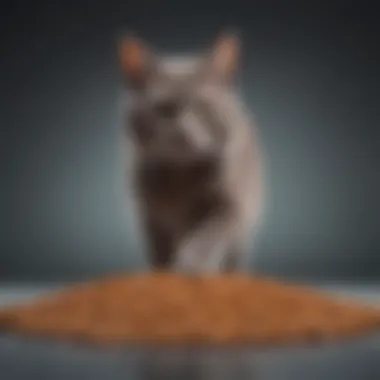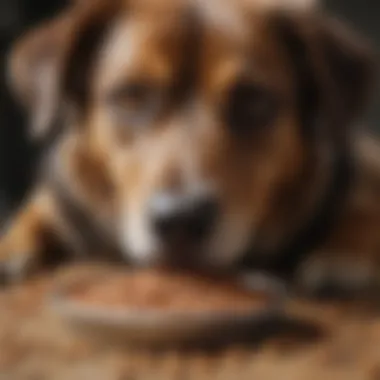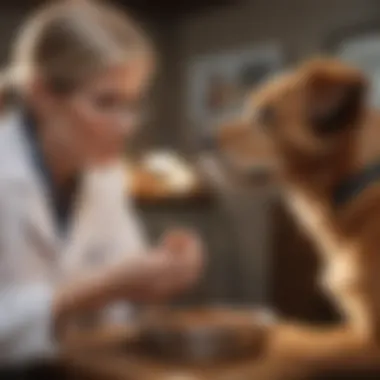Impact of Cat Food on Canine Health: A Detailed Review


Intro
The habits of our pets often draw our attention, particularly when we notice one type of animal appreciating the food meant for another. A common sight in many households is a dog savoring the contents of a cat bowl, which might seem harmless at first glance. However, these seemingly innocent cravings can beg deeper inquiry. Feeding cat food to dogs can lead to several potential health risks linked to the differences in the nutritional requirements between the two species.
While cats are obligate carnivores, their dietary needs are distinctly different from those of dogs, who are classified as omnivores. This discrepancy raises crucial questions regarding what might happen when the two species overlap in their diets. With more pet owners expressing concerns over their dogs’ health, it’s essential to delve into this issue.
Understanding the impact of cat food on canine wellness will help pet parents make informed decisions. And with various dog food brands flooding the market with different formulas, the importance of focusing on a balanced and appropriate diet can’t be understated. Dogs deserve the best, and knowing the consequences of feeding them inappropriate food is vital in ensuring their long-term well-being.
Prelude
Understanding the health implications of feeding dogs cat food is paramount for pet owners. In this article, we delve into significant areas concerning canine nutrition, focusing on how the unique dietary needs of dogs differ from those of cats. This exploration not just highlights nutritional disparities, but it also emphasizes the potential health risks that arise from inappropriate feeding practices.
Understanding Pet Nutrition
Pet nutrition isn't a one-size-fits-all deal. While dogs and cats are common companions, their digestive systems and dietary requirements reveal a different story. Dogs are omnivores, meaning they thrive on a varied diet that includes both animal and plant-based foods. In contrast, cats are obligate carnivores, requiring specific nutrients primarily derived from meat.
It's crucial for pet owners to grasp these differences to foster a healthy existence for their pets. For instance, proteins and fats play contrasting roles in their diets, which impacts their overall welfare. Dogs need a balanced mix, while cats may suffer from deficiencies if they don't get enough animal protein.
This nuanced understanding serves as a foundation for pet owners to make informed choices, ensuring they cater to their dogs' distinct dietary needs for optimal health outcomes.
The Rise of Shared Feeding
In recent years, a trend has emerged where pet owners tend to share meals among their pets, often leading to unintentional cross-feeding. This practice can be seen in households where cat food is left out and canines take the liberty to nibble at it. While it may seem harmless or even convenient, this practice brings a host of concerns.
The appeal lies in the convenience it offers—why prepare different meals when both cats and dogs can enjoy the same food? However, what might be a momentary solution can spiral into a health hazard for dogs. Many pet owners are unaware that cat food, while palatable, is often richer in fats and proteins than what dogs require.
Dog owners need to be on high alert. If their pooch has a sudden craving for feline cuisine, it may be important to understand how such habits could lead to adverse health outcomes. Therefore, keeping cat food out of a dog's reach is a sound first step in mitigating potential risks associated with shared feeding practices.
Nutritional Composition of Cat and Dog Food
Understanding the differences in nutritional composition between cat and dog food is essential in the context of canine health. This section digs into the unique aspects of both types of food and assesses implications for dogs if they consume cat food too frequently. Pet owners often need to balance the specific dietary requirements of their pets, considering factors such as age, activity level, and overall health. This comprehension can affect the long-term wellbeing of their canine companions.
Macronutrients Breakdown
Proteins
Proteins play a vital role in a dog's health, acting as building blocks for muscles and tissues. The aspect of quality is crucial here. Dog food typically contains proteins from sources like chicken, beef, or fish which are tailored to meet dogs' unique amino acid requirements. Generally, dogs fare better with proteins that are easily digestible. However, cat food often includes higher protein content from animal protein sources that could overwhelm a dog’s system if consumed constantly.
Key to remember is that while proteins in cat food can support growth and maintenance, excess can lead to weight gain and associated issues. Moderation is key, particularly for dogs with specific health concerns, such as kidney disease, where high protein intake may cause stress on their system.
Fats
Fats serve as a significant source of energy in dog food. They not only provide essential fatty acids but also help dogs absorb fat-soluble vitamins. In assessing cat food, it's notable that it usually has a richer fat content. This enhanced fat profile, while beneficial for cats who require it for their energy and insulation, can present challenges for dogs.


A dog’s diet derived from cat food may lead to excessive calorie intake, contributing to obesity and, subsequently, further health impacts like heart disease. Therefore, understanding the differences in fat composition is crucial for maintaining canine health.
Carbohydrates
Carbohydrates are less vital in a dog’s diet compared to proteins and fats but still supply essential energy. Dog food generally includes grains and vegetables that offer digestible carbohydrates, providing dietary fiber that aids in digestion. In contrast, cat food often contains fewer carbohydrates because cats are obligate carnivores and depend heavily on animal tissue.
Feeding dogs cat food can lead to imbalances, particularly a higher fat-to-carb ratio which is not ideal for their digestive system. It’s important for owners to keep in mind the significance of a balanced ratio to avoid digestive upset.
Essential Vitamins and Minerals
Vitamin A
Vitamin A is crucial for vision, immune function, and skin health in dogs. It should typically come from animal sources, yet many pet owners might not realize the variations in how vitamin A is presented in cat versus dog food. Cat food tends to have higher levels of preformed vitamin A, which can lead to a surplus in dogs if they consume too much cat food. This excess could result in toxicity, with symptoms ranging from loss of appetite to skin issues. Awareness of these nuances—especially with young, growing dogs—is vital in avoiding health complications.
Taurine
While taurine is an amino acid that plays a significant role in heart health, it is naturally produced in the dog’s body from other amino acids. Cat food is often enriched with taurine since felines need higher levels for proper heart and eye function. Through cat food, taurin can aid dogs, but excessive intake due to regular cat food feeding may have unclear long-term impacts. Owners should only consider taurine supplementation carefully, ideally through dog-specific sources.
Omega Fatty Acids
Lastly, omega fatty acids promote a healthy coat and skin while also providing anti-inflammatory benefits. Both dogs and cats can benefit from omega-3 and omega-6 fatty acids; however, the ratio matters. While cat food may push these ratios toward a cat dietary profile, dog food usually balances these proportions appropriate to their unique needs. If dogs consume cat food regularly, owners should pay attention to their coat condition and overall health, as there’s a risk of inflammation or skin allergies if they exceed needed levels of these acids.
Key Takeaway: The nutritional composition of cat food is not designed for dogs. While parts of it may not be toxic, long-term consumption can lead to significant health risks due to imbalances in necessary nutrients.
Physiological Differences Between Cats and Dogs
Understanding the physiological differences between cats and dogs is vital to appreciate why feeding cats' food to dogs could lead to serious health risks. Dogs and cats are not just distinct species; they have evolved divergent dietary needs and digestive processes tailored to their natural habitats and predatory behaviors. Cats, being obligate carnivores, rely heavily on animal proteins, while dogs, as more opportunistic feeders, necessitate a more varied diet. This reality elucidates the importance of formulating suitable diets for each animal type, based on their physiology.
Digestive System Differences
Dogs and cats share some basic anatomy features, but their digestive systems differ significantly in terms of design and function. Cats possess a shorter digestive tract that is perfectly suited for processing high-protein diets quickly. The stomach of a cat is quite acidic, providing an environment conducive to breaking down tougher proteins and allowing for faster nutrient absorption. In contrast, dogs have a longer gastrointestinal tract which reflects their omnivorous tendencies. This design enables them to extract nutrients from a broader range of foods, including plant materials.
The structural differences in their jaws also reveal crucial differences in dietary needs. Cats have sharp, flat teeth designed for puncturing and tearing meat, reflecting their carnivorous diet. Dogs, on the other hand, have a varied range of teeth aligned for grinding and shearing, hence accommodating a wider variety of food types.
Furthermore, the gastrointestinal microflora of dogs differs from that of cats. It’s tailored to handle fiber-rich foods, supporting their ability to digest carbohydrates.
"Understanding these distinctions is key to preventing missteps in pet nutrition that can lead to health woes."
These digestional differences emphasize that while sharing food may seem harmless, it's not merely a matter of convenience. Feeding dog cat food can disturb the balance of bacteria in a dog’s gut, potentially resulting in digestive turmoil that can escalate into more significant health issues.
Dietary Requirements
The dietary needs of dogs and cats diverge in several significant ways. Dogs have a greater requirement for carbohydrates compared to cats, which naturally limits their capacity to process cat food effectively. The necessity for certain nutrients like taurine found in high amounts in cat food is crucial for cats but is less critical for dogs.


Additionally, dogs require a balanced intake of vitamins and minerals that promote bodily functions, including joint health and immune support. A common misconception is that a dog's demand for protein is similar to that of a cat; during key life stages, like growth, lactation, or recovery from illness, dogs may require a different amino acid balance. The inclusion of specific filler ingredients in cat food can also pose risks to dogs since such elements may not be digestible or nutritious for them.
In summary, the physiological and dietary differences between cats and dogs serve as critical parameters guiding pet owners’ approaches to feeding. Recognizing these differences helps to mitigate health risks associated with improper feeding practices, ensuring that each pet meets its unique nutritional needs for a healthy, thriving life.
Health Risks Associated with Feeding Cat Food to Dogs
Feeding cat food to dogs may seem harmless at first glance, yet a number of health risks can arise as a consequence. The nutritional makeup between the two types of pet food differs significantly, leading to various complications when a dog consumes cat food regularly. Understanding these risks is essential for pet owners who might find themselves in a situation where they are tempted to share food between their pets. The focus here will be on both immediate health concerns and long-term effects linked to this practice, providing insight and guidance regarding how to protect your furry family member’s health.
Immediate Health Concerns
Feeding dog cat food can trigger a range of immediate health concerns, two of the most pressing being digestive upset and allergic reactions. These reactions underscore the biochemical differences between canine and feline diets, which can lead to substantial distress for our dogs.
Digestive Upset
One of the prominent issues when dogs consume cat food is digestive upset. Since cat food typically features higher protein and fat content compared to dog food, it can overwhelm a dog’s digestive system. The dog’s stomach, accustomed to a specific balance of nutrients, often responds adversely to such rich food. Symptoms can include vomiting, diarrhea, and even abdominal pain. Selecting a food that aligns more closely with a dog's biological needs is a wise choice for maintaining their gut health. In this context, digestive upset is important because it can lead the pet owner to observe key signs of distress. The moment a dog starts to show these symptoms, it should signal the need for an immediate change in feeding practices to avoid further complications.
Allergic Reactions
Another immediate concern is the potential for allergic reactions. Dogs may react adversely to proteins in cat food that they are not exposed to in their regular diet. This could manifest through itching, skin irritations, or gastrointestinal issues. The presence of specific ingredients, common in cat food but rare in dog food, can trigger immune responses that are uncomfortable for the dog. Pet owners should pay attention to any sudden changes in behavior or physical condition after a dog has ingested cat food, as swift recognition of allergic reactions can lead to prompt treatment and alleviate discomfort. The importance of awareness regarding allergic reactions lies in safeguarding the dog's well-being, making it imperative for owners to understand their pet’s dietary needs.
Long-Term Health Effects
While immediate reactions are concerning, the long-term effects of feeding cat food to dogs present even graver risks. Chief among these are obesity and pancreatitis, which can severely affect a dog's quality of life.
Obesity
Obesity is an alarming trend observed in many pets today, and feeding cat food can contribute to this growing problem. Due to the high caloric content of cat food, a dog can quickly gain excessive weight if fed improperly. This condition isn’t merely a cosmetic issue; it brings with it a host of health concerns, including joint problems, heart disease, and diabetes. Being aware of a dog’s weight is vital, not only for aesthetics but more so for maintaining a healthy lifestyle. If cat food becomes a staple in a dog's diet, this unregulated increase in weight can undermine the overall health, as the body struggles to cope with the excess fat.
Pancreatitis
Pancreatitis is another significant risk associated with long-term consumption of cat food. This condition arises when the pancreas becomes inflamed, stressing the organ and impairing its function, particularly in digesting fats. Dogs accustomed to lower-fat diets might struggle immensely when faced with the richness of cat food, leading to digestive disturbances and chronic health issues down the line. Monitoring a dog's response to various foods becomes crucial in preventing such debilitating conditions. Understanding the implications of pancreatitis brings to light the necessity for pet owners to be vigilant about what their dogs eat.
Ultimately, recognizing the health risks related to feeding cat food to dogs forms the foundation for making informed choices regarding pet nutrition. This understanding not only benefits the dog's physical health but also enhances the bond between pets and their owners.
Pet Owner’s Perspectives
Understanding the viewpoints of pet owners is crucial in the discussion surrounding feeding dog cat food. Many pet owners operate under various assumptions, often without being fully informed about the underlying nutritional science. This section delves into the common misconceptions and the reasons why some pet owners might choose to cross-feed their pets, either out of convenience or a lack of awareness about the potential health impacts.
Common Misconceptions
One prevalent myth among pet owners is that all pet food is created equal. This assumption can lead to detrimental choices, such as thinking that it’s safe to switch between cat and dog food whenever convenience strikes. Yet, it’s imperative to realize that dog and cat foods are formulated to meet the specific dietary needs of each species.
For instance, many owners may believe that since dogs and cats are both carnivores, cat food must be a viable option for dogs. However, cat food is typically much higher in protein and fat than dog food, which can overwhelm a dog’s digestive system and lead to digestive issues or even obesity over time.


Another misconception is that a dog's body can easily adapt to different types of food, a myth further perpetuated by the modern trend of shared feeding. While dogs can certainly have some degree of flexibility in their diet, it shouldn’t be misinterpreted as a free pass to consume any food intended for cats.
Reasons for Cross-Feeding
The reasons for cross-feeding often stem from the practical aspects of pet ownership. Here are a few common motivations:
- Convenience: Many owners find it easier to share one type of food, especially in households with both cats and dogs. This practice not only simplifies shopping but also mealtime routines.
- Cost: Cat food can sometimes be less expensive when purchased in bulk, leading owners to economize by feeding both pets the same food without considering species-specific needs.
- Taste Preferences: Some pet owners might notice that their dogs enjoy the taste of cat food more than their regular dog food, leading to the belief that it’s simply a better option.
Despite these reasons, it’s essential to weigh the potential health risks against the convenience gained. While it might seem harmless to feed your dog a few bites of cat food, repeatedly doing so can lead to serious long-term health issues. Understanding these perspectives sheds light on the need for pet owners to be more educated about what goes into their pets’ mouths.
Guidelines for Proper Pet Feeding
Feeding your pets may seem straightforward, but it can be quite a minefield if you’re not paying attention to the details. When it comes to your canine companions, a sound understanding of what constitutes proper nutrition cannot be overstated. Just like folks often have preferences in food, our pets have their specific dietary needs that must be respected. Today, we dive deep into what it means to feed dogs the right way, especially when cat food sneaks its way into the picture.
Understanding the guidelines for proper feeding not only ensures physical health but also enhances overall well-being. Dogs thrive on balanced diets tailored to their needs. The foods developed for our feline friends, while nutritionally adequate for them, can spell trouble for dogs in the long run. It’s crucial to recognize the unique needs of canines compared to their feisty feline counterparts. These differences lay the foundation for our feeding guidelines.
Identifying Quality Dog Food
When it comes to sourcing dog food, quality is king. A product's ingredients list should give you a peek into its nutritional value. The first few ingredients should ideally be specific animal protein sources, like chicken, beef, or fish, followed by whole grains and vegetables. Here are some pointers to ensure you find quality cans or kibble:
- Check the AAFCO statement: This indicates whether the food meets the nutritional standards set by the Association of American Feed Control Officials.
- Avoid vague terms: Ingredients labeled simply as “meat” or “animal by-products” often raise flags. Look for more precise descriptions instead.
- Real fruits and veggies: Nutrients from whole foods like sweet potatoes or carrots provide additional vitamins and minerals that dry food alone might lack.
“You are what you eat,” holds even more truth for your canine friend. Paying close attention to what’s in their bowl can mean the world to their health and longevity.
What to Avoid
Now that we’ve covered identifying quality dog food, it’s equally important to know what to cut out from their diet, including the sneaky cat food that might be around. Here are well-known culprits that simply don’t belong:
- High carbohydrate content: Unlike cats, dogs don’t require a diet rich in carbs. Foods that have grain fillers like corn can lead to weight gain.
- Excessive fats: Dog foods that don’t meet the right ratios of fats can pave the way for health issues, particularly pancreatitis.
- Artificial additives: Ingredients loaded with colors, flavors, or preservatives might make food appealing to us, but they don’t do much good for our dogs.
- Cats’ specific nutrients: Cats require arachidonic acid and taurine in their diet. While these are crucial for their health, too much can be harmful for dogs, leading to serious issues over time.
In summary, feeding your dog is more than just filling up their bowl; it entails a commitment to understanding their specific dietary needs. Quality dog food brings with it a plethora of benefits, while vigilance in avoiding harmful foods is equally essential to guard against potential health risks. Whether you're looking at the ingredients list or steering clear of the dreaded cat food, staying informed can go a long way toward your dog's health and happiness.
The End
The discussions held throughout this article emphasize the significant implications of feeding cat food to dogs. Understanding the core differences in nutritional requirements between these two species is vital. Dogs, despite their often affectionate nature towards feline fare, face various health consequences when their diets deviate from what their biology dictates. This summary has highlighted essential points that advocate for a thoughtful approach to pet feeding, providing clarity on the risks involved.
Summarizing Key Points
When summarizing the key elements of this discourse, several critical insights emerge:
- Nutritional Differences: The macronutrient profiles of cat and dog food diverge considerably. Cats require higher protein levels due to their obligate carnivorous nature, whereas dogs, being omnivores, require a more balanced mix of proteins, fats, and carbohydrates.
- Health Risks: Feeding dogs cat food can lead to immediate health concerns such as digestive upset or allergic reactions, while long-term repercussions can include obesity and pancreatitis. Understanding these risks is no laughing matter.
- Cross-Feeding Misconceptions: Many pet owners fall prey to the notion that if a little of something is good, then more must be better. This misguided philosophy can lead to neglecting the specific dietary requirements essential for canine health.
- Preventative Measures: Offering practical guidelines and advice can prevent pet owners from making harmful feeding choices. This includes recognizing what constitutes quality dog food and knowing what to steer clear of in cat food.
Such insights provide a comprehensive perspective on the potential dangers of feeding dogs cat food and highlight the stark nutritional contrasts that warrant careful consideration.
Encouraging Informed Decisions
In light of the knowledge presented, it is paramount for pet owners to make well-informed decisions regarding their canine companions' diets. Being educated about nutritional requirements and the repercussions of poor feeding habits not only benefits individual pets but also fosters responsible pet ownership as a whole.
- Prioritize Species-Specific Diets: Always favor food formulated specifically for dogs. This ensures they receive the correct balance of proteins, carbohydrates, vitamins, and minerals tailored for their unique needs.
- Consulting Professionals: Engaging with veterinarians or pet nutritionists can provide customized advice. They can help decipher the specific needs based on a dog's age, breed, and health status, turning any well-intended decisions into safe ones.
- Staying Updated: Pet nutrition is an ever-evolving field. By keeping abreast of the latest findings, pet owners can avoid pitfalls and nurture a healthy bond with their furry friends.
Understanding the gravity of these factors can lead to informed decisions that significantly enhance the health and well-being of dogs. The onus lies on the owner to actively pursue knowledge and act in the best interests of their pets.







